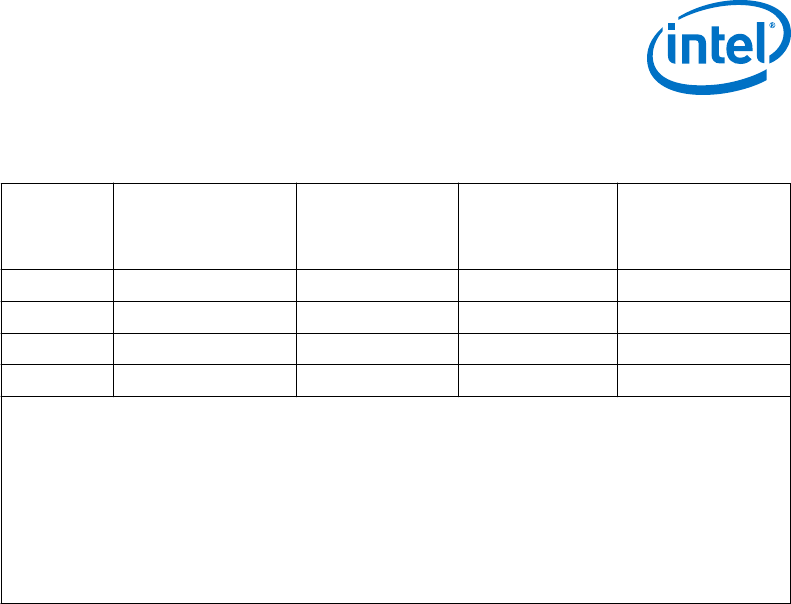Desktop 4th Generation Specification Sheet
Table Of Contents
- Contents
- Revision History
- 1.0 Introduction
- 2.0 Interfaces
- 3.0 Technologies
- 3.1 Intel® Virtualization Technology (Intel® VT)
- 3.2 Intel® Trusted Execution Technology (Intel® TXT)
- 3.3 Intel® Hyper-Threading Technology (Intel® HT Technology)
- 3.4 Intel® Turbo Boost Technology 2.0
- 3.5 Intel® Advanced Vector Extensions 2.0 (Intel® AVX2)
- 3.6 Intel® Advanced Encryption Standard New Instructions (Intel® AES-NI)
- 3.7 Intel® Transactional Synchronization Extensions - New Instructions (Intel® TSX-NI)
- 3.8 Intel® 64 Architecture x2APIC
- 3.9 Power Aware Interrupt Routing (PAIR)
- 3.10 Execute Disable Bit
- 3.11 Supervisor Mode Execution Protection (SMEP)
- 4.0 Power Management
- 4.1 Advanced Configuration and Power Interface (ACPI) States Supported
- 4.2 Processor Core Power Management
- 4.3 Integrated Memory Controller (IMC) Power Management
- 4.4 PCI Express* Power Management
- 4.5 Direct Media Interface (DMI) Power Management
- 4.6 Graphics Power Management
- 5.0 Thermal Management
- 5.1 Desktop Processor Thermal Profiles
- 5.2 Thermal Metrology
- 5.3 Fan Speed Control Scheme with Digital Thermal Sensor (DTS) 1.1
- 5.4 Fan Speed Control Scheme with Digital Thermal Sensor (DTS) 2.0
- 5.5 Processor Temperature
- 5.6 Adaptive Thermal Monitor
- 5.7 THERMTRIP# Signal
- 5.8 Digital Thermal Sensor
- 5.9 Intel® Turbo Boost Technology Thermal Considerations
- 6.0 Signal Description
- 6.1 System Memory Interface Signals
- 6.2 Memory Reference and Compensation Signals
- 6.3 Reset and Miscellaneous Signals
- 6.4 PCI Express*-Based Interface Signals
- 6.5 Display Interface Signals
- 6.6 Direct Media Interface (DMI)
- 6.7 Phase Locked Loop (PLL) Signals
- 6.8 Testability Signals
- 6.9 Error and Thermal Protection Signals
- 6.10 Power Sequencing Signals
- 6.11 Processor Power Signals
- 6.12 Sense Signals
- 6.13 Ground and Non-Critical to Function (NCTF) Signals
- 6.14 Processor Internal Pull-Up / Pull-Down Terminations
- 7.0 Electrical Specifications
- 8.0 Package Mechanical Specifications
- 9.0 Processor Ball and Signal Information

Table 26. Digital Thermal Sensor (DTS) 1.1 Thermal Solution Performance Above
T
CONTROL
Processor
TDP
Ψ
CA
at DTS =
T
CONTROL
1, 2
At System T
AMBIENT-
MAX
= 30 °C
Ψ
CA
at DTS = -1
At System
T
AMBIENT-MAX
= 40 °C
Ψ
CA
at DTS = -1
At System
T
AMBIENT-MAX
= 45 °C
Ψ
CA
at DTS = -1
At System T
AMBIENT-
MAX
= 50 °C
84 W 0.627 0.390 0.330 0.270
65 W 0.793 0.482 0.405 0.328
45 W 1.207 0.699 0.588 0.477
35 W 1.406 0.753 0.610 0.467
Notes: 1. Ψ
CA
at "DTS = T
CONTROL
" is applicable to systems that have an internal T
RISE
(T
ROOM
temperature
to Processor cooling fan inlet) of less than 10 °C. In case the expected T
RISE
is greater than 10
°C, a correction factor should be used as explained below. For each 1 °C T
RISE
above 10 °C, the
correction factor (CF) is defined as CF = 1.7 / (processor TDP)
2. Example: A chassis T
RISE
assumption is 12 °C for a 95 W TDP processor:
CF = 1.7 / 95 W = 0.018 /W
For T
RISE
> 10 °C
Ψ
CA
at T
CONTROL
= (Value provide in Column 2) – (T
RISE
– 10) * CF
Ψ
CA
= 0.627 – (12 – 10) * 0.018 = 0.591 °C/W
In this case, the fan speed should be set slightly higher, equivalent to Ψ
CA
= 0.591 °C/W
Fan Speed Control Scheme with Digital Thermal Sensor
(DTS) 2.0
To simplify processor thermal specification compliance, the processor calculates the
DTS Thermal Profile from T
CONTROL
Offset, TCC Activation Temperature, TDP, and the
Thermal Margin Slope provided in the following table.
Note: TCC Activation Offset is 0 for the processors.
Using the DTS Thermal Profile, the processor can calculate and report the Thermal
Margin, where a value less than 0 indicates that the processor needs additional
cooling, and a value greater than 0 indicates that the processor is sufficiently cooled.
Refer to the processor Thermal Mechanical Design Guidelines (TMDG) for additional
information (see Related Documents).
5.4
Thermal Management—Processor
Desktop 4th Generation Intel
®
Core
™
Processor Family, Desktop Intel
®
Pentium
®
Processor Family, and Desktop Intel
®
Celeron
®
Processor Family
December 2013 Datasheet – Volume 1 of 2
Order No.: 328897-004 73










